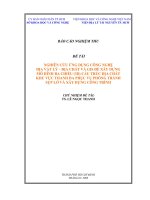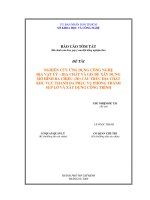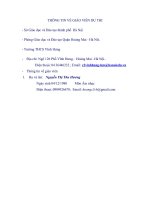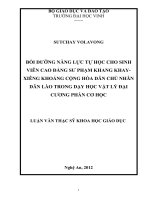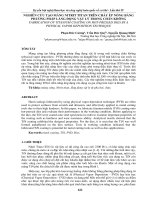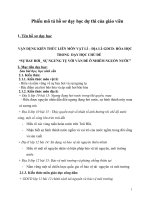VẬT lý địa CHẤN geoelectric
Bạn đang xem bản rút gọn của tài liệu. Xem và tải ngay bản đầy đủ của tài liệu tại đây (4 MB, 32 trang )
Electrical Surveying
•Exploit the differences of various electrical properties of rock and minerals.
•Resistivity method
•Detects horizontal and vertical discontinuities in the electrical properties of the
ground.
•Detects 3-D bodies of anomalous conductivity.
•Hydrogeology and engineering applications for the shallow subsurface.
•Induced Polarization
•Makes use of the capacitive action of the subsurface to located zones where
conductive materials are disseminated within host rock.
•Self Potential
•Uses natural currents generated by electrochemical processes to locate
shallow bodies of anomalous conductivity.
Resistivity
•Resistivity usually depends on the amount of groundwater present, and on the
amount of salts dissolved in it
•Resistivity is often used for mapping the presence of rocks with different
porosities.
•Hydrogeology – aquifers, contaminant transport, saline pollution
•Mineral prospecting
Artificially generated currents are introduced into the ground and the resulting
potential differences are measured at the surface.
Basic Electrical Quantities
Electrical charges flow around a circuit – current flows from positive to negative
From: Mussett & Khan., 2000
Electrical current is measured in amperes (amp) –
the amount of electric charge that passes any point
in the circuit in 1 second.
The current flows due to a potential difference
(Voltage). A 1.5 volt battery produces a potential
difference of 1.5 volts.
For most materials, the current increases in
proportion to the potential difference – double the
potential difference, the current doubles. Ohm’s Law
The amount of current flowing when the potential
difference is 1 volt is called the resistance of the
piece, and is equal to the slope of the graph to the
right
V
= R (Ω )
I
Basic Electrical Quantities
Resistance depends on the material and its shape:
•A wire of copper has less resistance than one of lead with the same
dimensions.
•A long thin wire has greater resistance than a short, fat one of the same
material
•Doubling the length doubles the resistance
•Doubling the area of cross-section halves the resistance (similarly to
water flow).
From: Mussett & Khan., 2000
Resistivity (the quantity investigated by resistivity surveying) characterizes the
material independent of its shape – it is measure in ohm-m (inverse of resistivity is
conductivity)
length
resistance = resistivity *
cross - sectional area
resistivity = resistance *
cross - sectional area
length
From: Mussett & Khan., 2000
From: Kearey et al., 2002
Rock and Mineral Resistivity
Though some very good conductors (low
resistivity) and insulators (high resistivity) do
occur naturally (silver and quartz respectively)
most rocks fall somewhere between, but with a
wide range of resistivites.
Rock and Mineral Resistivity
Most rock forming minerals, i.e. quartz, feldspar, mica, olivine, are good insulators.
Pores and cracks contain groundwater (fairly low resistivity) – resistivity of rock
is therefore a function of porosity and pore saturation.
Water varies from pure (insulator) to salty (good conductor).
Salts dissociate into positive and negative ions – common salt dissociates
into Na+ and Cl- -- these move through the water forming a current
= Ionic conduction (electronic conduction is due only to electrons –
occurs in metals and some ores).
From: Mussett & Khan., 2000
As the resistivity of a rock is largely due to the pore waters, a single rock can
have a large range of resistivites, making lithological identification problematic.
Rock and Mineral Resistivity
•The resistivity of porous, water bearing sediments (formation resistivity, P p) can be
approximated from the porosity (Ф), the water saturation (Sw) and the resistivity of
the pore water (ρw) – Archie’s Law
ρ t = aρ wφ s
−m −n
w
ρw
=a m n
φ Sw
Where a, m, and n are constants determined from field of lab measurements – used
commonly in the hydrocarbon industry.
•Archie’s law does not hold for clay minerals – the fine particles trap a layer of
electrolyte around them – clay has low resistivity.
•Resistivity decreases as temperature rises – needs to be accounted for in borehole
logging.
Electrical Flow in Rocks
From: Mussett & Khan., 2000
Electrical connections are made through electrodes – metal rods pushed a few cm
into the ground
The current does not travel by the most direct route – as a thin layer has the most
resistance, the current instead spreads out, both downwards and sideways, though
there is a concentration near the electrodes.
In uniform ground only about 30% of the current penetrates below a depth equal to
the separation of the electrodes.
Why
4
Electrodes?
•So far we have only used two electrodes. In this case
•This is not done in resistivity surveys because there is a
large and unknown extra resistance between the
electrode and the ground.
•The potential difference is instead measured between
two other two potential electrodes – the voltmeter draws
negligible current, therefore the contact potential
difference is negligible.
•Power supply usually run from batteries.
•Wires have small resistances.
•Applied voltage ~100 volts, current ~mA
•Potential difference typically volts to mV.
•As ions accumulate on the electrodes, they are
dispersed by reversing the current flow a few times a
second.
From: Mussett & Khan., 2000
the potential difference is measured between the ends of
the resistance.
Vertical Electric Sounding
Vertical electric sounding is used when the subsurface approximates to a series of
horizontal layers.
•The electrode array is expanded from a fixed center.
•If the electrode spacing is much less than the thickness of the top layer, nearly
all will remain in that layer.
From: Mussett & Khan., 2000
•As the electrode spacing is expanded beyond the thickness of the top layer, a
significant amount of the current will be flowing through the lower layer.
In a uniform layer the current paths are smooth
The current paths refract towards the normal as they
cross into a rock of higher resistivity, and away when
they cross into a rock of lower resistivity. The angles
are related by:
ρ1 tan θ1 = ρ 2 tan θ 2
From: Mussett & Khan., 2000
As refraction changes the distribution of current in a layered subsurface,
compared to uniform ground, the ratio of the potential difference to the current
changes, making it possible to measure the change of resistivity with depth.
From: Mussett & Khan., 2000
Refraction of Current Paths
Apparent Resistivity
In a VES survey the ratio of current to potential difference changes because:
•Change of resistivity with depth
•Because electrodes are moving further apart
The second effect has to be removed
•As current travels through the ground the current paths diverge from one
current electrode before converging on the other.
From: Mussett & Khan., 2000
•Resistance of “bundle of paths” is proportional to length, but inversely
proportional to cross-sectional area
From: Mussett & Khan., 2000
Apparent Resistivity
•If the current electrode separation is doubled, the cross-sectional area quadruples,
so the resistance halves.
•The ratio of potential difference to current, ΔV/I has to be multiplied by a
geometrical factor that depends on the electrode separation:
ρ a = geometrical factor *
∆V
I
The factor is such that, for a uniform subsurface, ρa remains constant as the
separation is changed and equals the resistivity of the ground
a
ρ
I
j=
2
4πl
j =−
1
ρ
gradU = −
1 δU l
ρ δr l
ρI dl
⇒ dU = −
4π∞ l 2
U (∞ ) − U (l ) = ∫ dU =
l
U (l ) =
Iρ
4πl
Iρ
4πl
UM =
Iρ 1
1
(
−
)
2π AM BM
∆U
ρ =k
I
Iρ 1
1
(
−
)
2π AN BN
Iρ 1
1
1
1
⇒ ∆U =
(
−
−
+
)
2π AM BM AN BN
UN =
K = 2π
1
1
1
1
1
−
−
+
AM
BM
AN
BN
Wenner Array
In a Wenner array, the electrodes are equally spaced (spacing = a).
•Geometrical factor = 2πa, therefore ρa = 2πa ΔV/I
•In uniform ground doubling a halves ΔV/I , with ρa remaining constant.
From: Mussett & Khan., 2000
•If the subsurface is layered, the value of ρa depends on the resistivities of the
layers – the value calculated is the apparent resistivity. As the electrode
separation is expanded ρa changes as more current flows into deeper layers.
Wenner VES Survey
•Four electrodes pushed into the
ground symmetrically about the
junction of the tapes.
•Electrode separation
progressively increased – not
incrementally as the same
increment at a wide spacing
would produce little or no change
in reading – ie 1, 1.5, 2, 3, 4, 6,
8.
•Stopped when current is deep
enough.
From: Mussett & Khan., 2000
•Two measuring tapes laid end to
end.
Wenner VES Survey
•Apparent resistivity is calculated for each spacing, using ρa = 2πa ΔV/I
From: Mussett & Khan., 2000
•Graph is plotted of log10ρ vs log10a.
•The curves are both for two
layer cases – same resistivities
but different thickness upper
layer.
•At small electrode spacing the
current only penetrates the
upper layer. The apparent
resistivity at small spacing is
therefore the resistivity of the
upper layer.
•At the largest spacing the curve flatten – here most of the current is spending most
of its time in the lower layer. Therefore the resistivity of the lower layer
approximates the apparent resistivity at large spacing.
•The fact that the upper layer is thicker in the right-hand plot is apparent from the
longer time spent at low apparent resistivity.
From: Mussett & Khan., 2000
Modeling the Data
Modeling the Data
•Electrode spacing is plotted as a ratio to
the thickness of the top layer, a/h1, and
the apparent resistivity as a ration to the
resistivity if the top layer ρa / ρ1, with
different curves labeled by the value of
the ratio of the resistivities.
•The master curve and
apparent resistivity
curves must be on the
same scale.
From: Mussett & Khan., 2000
•In practice the thickness of the layers
and the resistivities are found by
comparing the actual plot with master
curves calculated for different values of
thickness and resistivity.
Modeling the Data
•The apparent resistivity plot
is slid over the master curve
until a match is found.
•The horizontal part of the
curve cuts the y-axis at 1.27,
giving a value of 18.9 ohmm for layer 1 (ρ1).
•The value for layer 2 is thus
6 * 18.9 = 113 ohm-m (ρ2).
•The thickness of the top
layer is found from where
the a/h1 curve of the master
curve cuts the x –axis on the
apparent resistivity curve –
in this case 0.2 m.
From: Mussett & Khan., 2000
•In this case it would be the
ρa / ρ1 = 6.
Multiple Layers
•The number of layers
can be determined by
the number of changes
from concave to convex,
or vice versa – kinks.
•This is the minimum
number of layers.
•In reality, modeling for
multiple layers is usually
done on a computer,
where a theoretical
master curve can be
compared actual data
and a depth vs.
resistivity curve created.
From: Mussett & Khan., 2000
In the case of multiple layers, the curve never reaches the resistivity of layer 2 as the
current is penetrating into yet deeper layers.
Limitation of VES
•Thin layers, or layers with negligible resistivity contrast are said to be suppressed.
•No hard guidelines on the limits of thickness of a detectable layer – usually
estimated by modeling.
•Anisotropic layers have resistivities that vary perpendicular to lamination (shale).
From: Mussett & Khan., 2000
•The method assumes that layers are horizontal – if they are dipping, are series of
VES profiles should be carried out.
•Ambiguity


